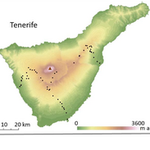Abstract
Aims Elevational patterns of plant species richness may be caused by multiple underlying mechanisms, and the same pattern can be predicted by different mechanisms. Using the steep elevational gradient of Tenerife as a model system, we aimed to test if the application of a trait-based approach can help disentangle the role of potential mechanisms behind local elevational plant species richness patterns.
Location Tenerife, Canary Islands, Spain.
Methods Based on vegetation relevés from natural vegetation and disturbed roadside habitat, along an elevational gradient of 2300 m, we observed a peak of plant species richness in the lowest third of the gradient. We considered three mechanisms potentially shaping this pattern: environmental filtering (temperature and precipitation), effects of area and disturbance. For these mechanisms, we hypothesized a distinct pattern of functional trait–elevation relationships. These were tested with in-situ data of nine functional leaf traits, from which we calculated community-weighted means (CWM) of traits and functional diversity (Rao’s Q).
Results While species richness was significantly positively correlated with temperature, area and disturbance, filtering through temperature was the only mechanism for which we could confirm most of our mechanism-specific hypotheses about elevational trait changes: with increasing elevation, CWMs of most traits indicated shifts from acquisitive to conservative growth strategies, and functional diversity decreased. The shift of growth strategies also supported the disturbance effect, as we found overall more acquisitive communities at roadsides compared to natural habitats.
Conclusions Our results indicate that simple correlations between species richness and abiotic variables are not necessarily causal. Additional testing of mechanism-specific hypotheses for elevational patterns of both CWMs and functional diversity can help distinguishing between correlational and mechanistic relationships between species richness and environmental variables. The trait-based framework presented here can be fruitfully applied to better understand species richness patterns in other regions and across other types of environmental gradients.
